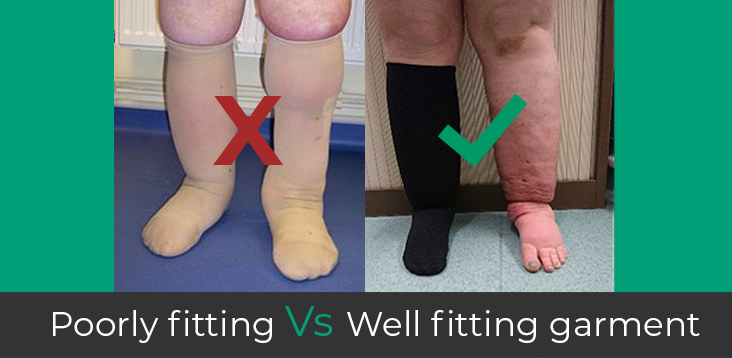Which type of compression fabric is right for me?
Posted by Sue Lawrance on 20th Apr 2020
In the management of lymphoedema and chronic oedema, we use different types of compression depending on the degree of swelling involved, and the underlying cause of the problem. This compression may initially be in the form of bandages or adjustable Velcro wrap systems, but usually progresses on to compression garments (socks, stockings, or armsleeves) for long-term maintenance.
How compression works, and how useful it is in managing oedema, has been discussed in a previous blog post (The Benefits of Compression). However, the aim of this article is to explain why different types of fabrics are used and how your therapist chooses the most appropriate fabric for your individual circumstances.
How to decide what type of compression garment to use
Prior to being prescribed a compression garment you may have required a course of intensive treatment such as bandaging or a wrap to reduce the initial amount of fluid build-up. Once completed you are now in the next phase of management, i.e. maintaining that fluid loss and continuing to improve your limb size and shape.
However, your limb may not have required an intensive course of treatment or bandaging. In this case, you will simply be prescribed the most appropriate garment for your circumstances.
Either way, your therapist will take the following factors into consideration when deciding on the correct garment:
- Limb shape – Is your limb a “normal” shape, or are there some skin folds?
- Limb size – How much bigger than “normal” is your limb?
- Skin condition – Is your skin in good condition, intact or broken, dry, fragile?
- Tissue condition – Does your limb feel firm to the touch, soft, or “squishy”? Does your thumb leave a dent if you apply pressure to the limb?
- Return of swelling – How quickly does the swelling return once any compression is removed?
- Ease of donning – How able are you to put a garment on and take it off?

Circular-knit garments
Circular-knit garments are the lighter type of compression garment that therapists prescribe, and are often thought of as more cosmetically preferable. As a rule, they are used for limbs that are “limb-shaped”, are not that much bigger than your “normal” size, where the skin is intact and in good condition, and the tissues feel “normal” (or maybe slightly firmer than “normal”), but not hard to the touch.
These garments are made on a circular knitting machine (see above), so they are essentially a shaped tube of soft stretchy elastic. As a result, when stretched over a limb, the elastic fabric tries to return to its original size, a bit like an elastic band. So, if your limb is too big, has any skin folds, or the tissues are too soft, the elastic will rebound, roll down, and dig in where there are any shape changes (see example of a poorly fitting garment below). This is very uncomfortable and potentially damaging as it can act a bit like a tourniquet. Therefore, garments MUST fit correctly and be removed if the above happens. If you experience this sort of problem, you are wearing the wrong type or size of garment, and you will need to contact your therapist to have a review.

Flat-knit garments
Flat-knit garments are thicker and look more chunky than circular-knit garments. For this reason, they may not be your first choice of garment. However, they may be the most appropriate for your condition, in which case you will probably be surprised how comfortable they are once fitted.
Flat-knit garments are often used immediately after a course of bandaging or wrap therapy, if you have a limb with any shape distortion or skin folds, if you have firmer tissues, or if you have swelling that is more difficult to control.
These garments are very different from circular-knit garments: they are knitted as a flat piece of fabric (usually custom-made for your limb shape), the edges of which are then sewn together. The fabric feels firmer and more rigid compared to circular-knit garments.
The construction of these garments means they lie flat on your limb, and won’t roll or dig in if there are any small skin folds.
Style and compression of garments
The style of garment chosen will depend on where your swelling is, and how extensive it is, e.g. reaching up to just below your knee, or extending over and around your knee. Characteristics such as these will determine whether a below-knee, or thigh-length, garment is chosen.
Likewise, the amount of compression required will be dictated by the characteristics of your very individual oedema. This way, you will get the best possible garment for the ongoing management of your swelling.
The Haddenham Healthcare range of circular-knit and flat-knit garments is extensive, allowing your therapist to prescribe you a garment to suit your individual needs.
About the author
With a background in vascular surgery & District nursing, chronic oedema & lymphology have been the focus of Sue’s nursing career for the past 30 years. Since 1997 Sue has developed and managed the Lymphoedema service for Mid & North Bucks based at Florence Nightingale Hospice, Aylesbury. The service is nurse led & treats Primary & Secondary Lymphoedema along with an increasing caseload of chronic oedemas.